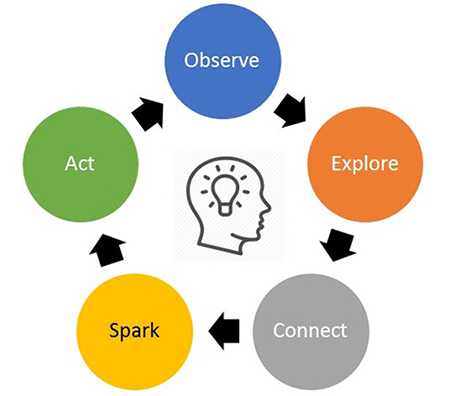The Actuary’s Journey to Becoming a Strategic Business Partner: Strategic Thinking
By Michael Seitchik and Barbara Taylor
The Stepping Stone, March 2021

In our previous article,[1] we focused on how you, as an actuary, can move into the influential role of strategic business partner and described four developmental stages:
- Subject Matter Expert (SME)—Having competent actuarial skills to accurately complete needed work but little power or influence on larger decisions. Your main role is to provide information.
- Reactive Problem Solver—Adding more value by helping others solve specific issues when asked. Your value has grown because you now provide solutions, not just technical information or advice.
- Proactive Catalyst—Being able to provide a number of solution options and importantly, anticipating issues that others may not immediately see. At this point, you begin to build credibility and a reputation that causes others to listen.
- Strategic Business Partner—Building strong relationships with key leaders so that they have confidence in you to feel they can reveal their thoughts and possible business uncertainties. In this role, you become an important confidant and your influence level increases exponentially.
This follow-up article looks at how to become a strategic thinker—a crucial skill set to move beyond SME to either a proactive catalyst or ultimately, a strategic business partner. Becoming an actuarial strategic thinker will open you to a wider business world filled with multiple perspectives, creativity and, believe it or not, fun!
What is Strategic Thinking?
This is a great question and there is much confusion as to its meaning. Often, professionals are asked to be more strategic without any idea of what this entails or how to accomplish it.
We have developed a global strategic thinking definition:
“A fresh perspective you provide that gives others new insights into current and future business/operational issues and impacts the ability of the company to compete.”
Thinking strategically requires you to be able to think outside-the-box to solve current or future business challenges or environments. You may offer a completely new idea or one that provides a different way to look at today’s business products or operations within your company.
Strategic thinking means you need to pull yourself away from your normal work routines to see patterns, to be open to other possibilities and to have the courage to take on something that may not ultimately work or be accepted in the long-run.
Our research has uncovered that strategic thinking is a circular process that includes five steps.
Figure 1
Strategic Thinking Model

Using the above strategic thinking model and process, let’s look at a number of specific actions or behaviors you should incorporate into the way you work to become known as an actuarial strategic business partner.
We’ll start at the top of model of the process.
Observe
It can be hard to pull yourself away from all the work that is in front of you; to not just follow your job description and the way things have always been done within your company. A key strategic thinking action is to build into your work routine time to just “sit back” and look at what is around you—what’s working, what isn’t, etc. Take the time to reflect and be curious. You’ve probably heard this before and perhaps have shrugged it off. However, strategic thinkers take this seriously and observe becomes an important step to broadening their outlook.
Active actions you can take during this stage are:
- Read. Keep current in company information, industry news and what is happening in other industries that can affect your company’s strategy or operations.
- Attend (or during this time of social distancing, virtually attend) conferences, webinars, video conferences.
- Increase your networks. Internally, connect with key strategic connections within your company. Externally, identify experts with whom you should develop business relationships. Look at how to broaden your knowledge levels and perspectives.
Explore
As you increase your knowledge, connections and perspectives during observe, you may find some interesting business dilemmas, concepts or opportunities that you want to delve into on a deeper level. In this stage, the networks you developed in observe will be important. To avoid pitfalls or figure if some of your preliminary ideas have “legs,” you should:
- Begin to flesh out your observations with deeper analysis.
- Get feedback, input, suggestions, dialogue and brainstorm with your network.
- Increase your political savvy to gain potential champions and avoid landmines.
Connect
During connect, you begin to create possible solutions and new ideas. It’s important to uncover patterns and create potentially new, alternative and better business models. Strategic thinking requires being able to not only zoom into the details, but also to be able to develop big picture approaches. You may need to synthesize old concepts with new perspectives and data. Your actuarial skills may give your knowledge depth; now it’s time to build knowledge breadth.
Recommended actions include:
- Begin to look for unintended consequences and commonalities across different functions, business units or services.
- Identify specific business and strategic champions who will be needed to endorse your ideas and possible solutions.
- Begin to think through those proverbial “sacred cows” that all companies develop.
Spark
Spark is an energizing step. At this stage, you should fully engage with people about your well-thought-out ideas. Here is where you present your insights, stimulate discussion and move others to see new ways of looking at issues, products or how work is currently being done. Getting others to understand, support and even build on your idea is like lighting a match and seeing your vision spread across key people.
Realize that this is not the time to think you can accomplish your new ideas by yourself. You will want to share your observations and insights. Be ready to provide data and rationale. Be ready to answer hard questions but also to ask others thought-provoking questions to encourage new ways of thinking. This is a building step so look at how to incorporate additional ideas from peers or senior leaders.
For some actuaries, this phase can be uncomfortable. It means taking more of a visible role by putting forth your own ideas before a group as well as working with others to develop new alternatives to workplace issues or challenges. In spark, you will want to:
- Join cross-functional taskforces and get involved in brainstorming sessions.
- Suggest alternatives to workflow, products, services, etc.
- Increase your influence and persuasion skills.
- Be positive, confident and enthusiastic.
Act
This is where all your work is pulled together by making specific recommendations to key people—your peers, your manager, senior executives, etc. Here is where you begin to flex your influence and start to experiment with new approaches. You’ll want to get people to buy-in and support your ideas.
The act step requires you to be:
- Politically savvy. What is important here is knowing who you need to get involved and how best to approach them.
- An effective internal/external networker. Use your network to help you think through how best to proceed.
- Able to present your ideas in a clear, concise and compelling manner. Elevate your presentation and writing skills so you can best convince others about your new solutions and ideas.
Final Thoughts
We’ve presented our strategic thinking model in an organized step-by-step way. However, strategic thinking can be messy. Yes, many times these steps go in a specific order—but not always. It’s possible to start almost anywhere and it is not uncommon to work, at times, backwards or to repeat steps as well.
Becoming a strategic thinker means you will need to expand your knowledge and thinking. Staying in your own lane won’t push your strategic thinking potential or have others regard you as a voice to be listened to. Actuaries know about risk—and you will have to decide how much risk you want to take on by recommending business changes. The good news is that by following our strategic thinking model you will have followed a sound process that mitigates this risk ... and while hard work, you will find it both rewarding and even invigorating. By gaining proficiency in strategic thinking, you will elevate your capability and become an influential and respected actuarial strategic business partner.
Statements of fact and opinions expressed herein are those of the individual authors and are not necessarily those of the Society of Actuaries, the editors, or the respective authors’ employers.
Michael Seitchik is the founder of Michael Seitchik LLC, a firm specializing in executive coaching and change management. He consults on a number of topics including leadership development, implementing change, strategy development and execution, influence skills, constructive conflict and creating mutually accountable teams. He can be reached at michael@michaelseitchik.com. LinkedIn: https://www.linkedin.com/in/michaelseitchik/
Barbara Taylor is a business partner at Janbara & Associates and cofounder of Silo-Busting Networking. She coaches executives and designs creative leadership development programs. Barbara is Beacon’s Membership Committee Chair. She can be reached at btaylor@janbara.com. LinkedIn: https://www.linkedin.com/in/barbarataylor123/
